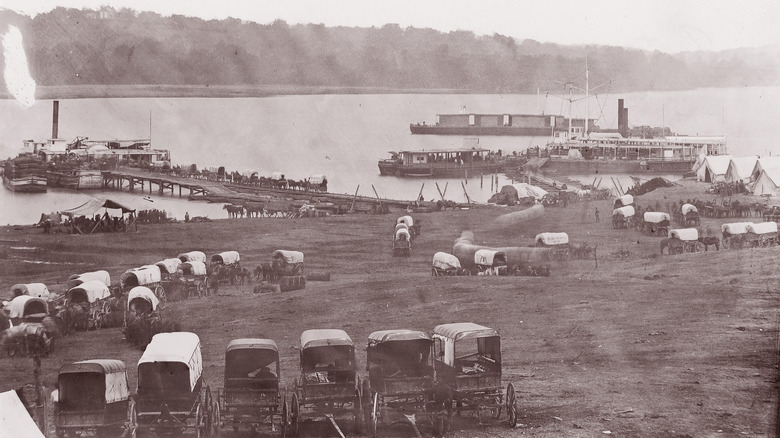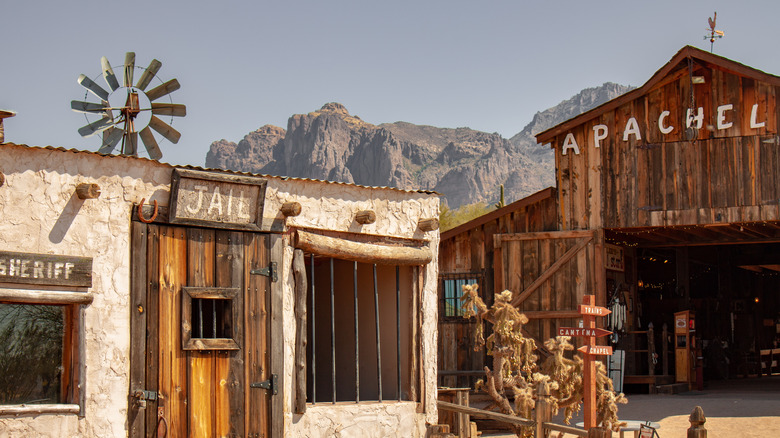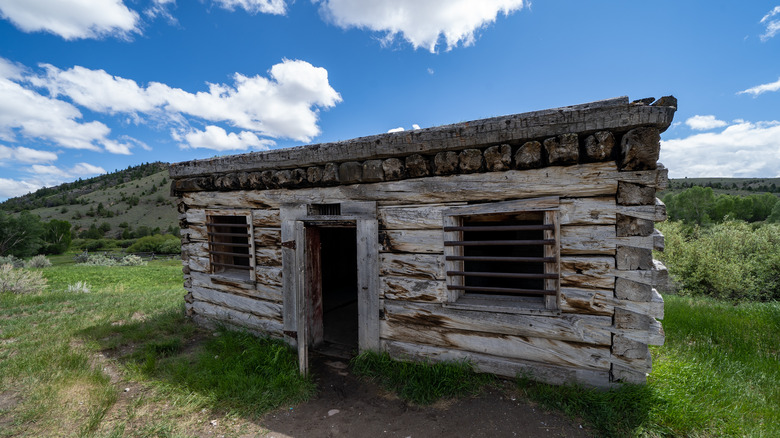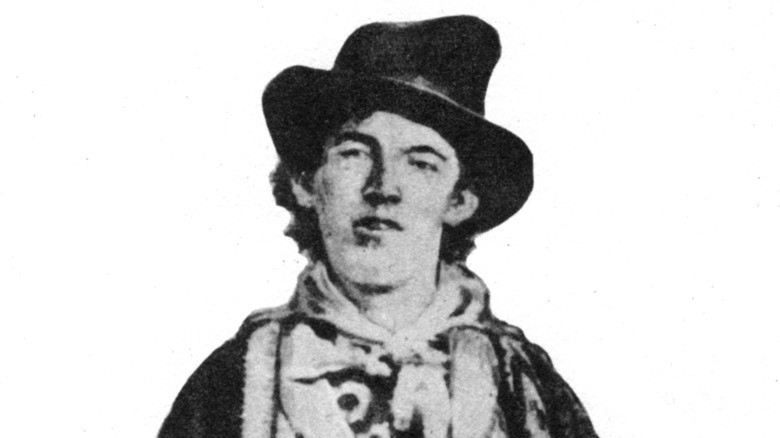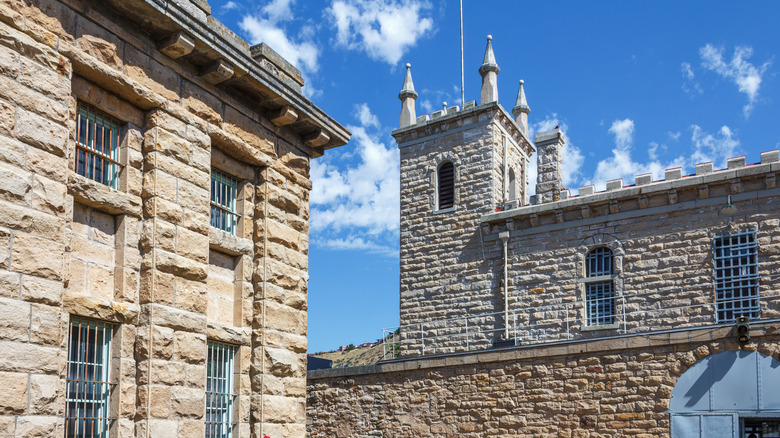Here's What Jails Were Like In The Old West
While the Old West has certainly been romanticized over the years thanks to countless books, TV shows, and films, the truth of the matter is that it was not an easy place to live. The weather was always either really hot or really cold, disease was rampant, and everyone walked around jangling their noisy spurs. (At least everyone got to wear some pretty cool hats.)
According to the Library of Congress, a huge reason for people traveling west had to do with post-Civil War railroad expansion making areas that were once difficult to access, much easier — and safer — to reach from the east than they had ever been. Some ventured west to mine, others to farm, and others to start some other sort of new life. Meanwhile, others went there to rob all of those people. Or, at least that's what Hollywood would have you believe.
While the crime rates aren't the absurd highs one would expect after watching any shoot-'em-up western, according to Ohio State University's Criminal Justice Research Center, murder rates were still high by both contemporary and modern standards. According to How Stuff Works, that newspapers in that era would exaggerate instances of crime or violence, perhaps leading to the west's reputation for lawlessness. Of course, it wasn't entirely lawless, and those who ran afoul of those laws could end up in less than pleasant western prisons.
Punishment en route to the West
Crimes did occur in the old west — and even on the way there — and some of the era's less admirable characters went on to become the stuff of legend. According to Legends of America, before traveling west, wagon trains would usually draft up some semblance of a miniature constitution, as the sometimes large groups consisting of people from different backgrounds were essentially moving towns. These constitutions or sets of regulations outlined the group's rules and how they would settle any disagreements that popped up along the trek.
Punishments and the methods of reaching them varied, depending on the severity of the crime. For instance, minor crimes would only involve some kind of mediation, while serious crimes like murder or horse-stealing would result in throwing together the wagon train version of a traditional courtroom, with fellow travelers acting as the jury. Most of the time, these people found the accused guilty, and with no prisons to stash them in, they found the nearest tree or built a makeshift gallows and executed them.
Western jails varied in their construction
According to Old Prisons, one of the first buildings in many new western towns was a jail. How these were constructed and what they were made out of varied a great deal. Usually, the materials that were used were whatever was on hand and easy to access. If a town was being built in or near a forest, where timber was plentiful, then that's what they'd use. If stone was abundant nearby, then that would be the favored material. Sometimes a town was lucky enough to set up shop close to where bricks were already being produced, and then those were used to construct a jail.
While any of these materials would've done the trick in the short term, many of the wooden jails — or any other wooden building, for that matter — haven't always stood the test of time. Fires were fairly common in the old west, and a wooden jailhouse surely went up like a tinder box, whereas its stone or brick counterparts were more likely to hold up in the event of a fire. Some of the stone prisons — like Arizona's Yuma Territorial Prison, which was built in 1876 — are still standing today (via St. Louis Dispatch).
Western jail windows and roofs
Whether an inmate was being kept in a small local jail, or one of the larger territorial prisons, it wasn't the kind of experience they would want to seek out again in the future. According to Leisure Group Travel, most of the prisons were completely devoid of modern conveniences, which is saying a lot, because virtually the entire old west was devoid of modern convenience, so if the prisons were archaic by those standards, it must have been bad.
However, according to True West Magazine, just like the construction methods, the conditions in jails varied greatly, too. For instance, some had windows that allowed prisoners to get a little bit of vitamin D while wasting away in their cell, while others didn't. Some weren't even fortunate enough to have a roof over their heads while serving time. Some towns didn't have a jailhouse, so they had to come up with other methods of keeping their inmates contained. In Wickenburg, Arizona, their solution was to chain the inmates to a tree. These inmates were usually just drunks, not violent criminals or outlaws, and they were set loose once the whiskey wore off.
Escapes were somewhat common ... and not particularly difficult at times
Whatever solution a town found for keeping their criminals incarcerated, most of them were far from watertight. According to Old Prisons, in smaller towns, whoever was in charge of the prison typically didn't stay there overnight and the prisoners were left unattended. One prisoner used this opportunity to saw his way out of a wooden jail. How he got a saw into the jail is another question entirely, but the point is he managed to free himself and no one noticed he was gone until the next day — plenty of time to get a jump start on any lawman who tried to track them down.
Some of the West's most notorious outlaws had their fair share of escapes, too. According to History, the legendary Billy the Kid (above) once escaped from a New Mexico jail by climbing up the building's chimney and fled to neighboring Arizona. Another escape was accomplished by a group of cowboys lifting the corner of the jail cell, allowing their compatriot to wriggle out from underneath.
Life in larger penitentiaries
While some of the old west's jails and prisons are long gone, some are still around today, while others are not only standing but housed inmates well beyond the old west era. One of these, according to Leisure Group Travel, was the Old Idaho Penitentiary. The penitentiary was built in 1870 and over its time as an operational correctional facility, it hosted more than 13,000 inmates.
Prisoners' experiences in a place like the Old Idaho Penitentiary were quite different from those housed in small-town jails. While the penitentiary started as a one-room operation it quickly expanded into a multi-building complex. Here, better-behaved prisoners had the opportunity to work in some of the penitentiary's gardens.
Still, the conditions were harsh — so too were the guards — but those conditions didn't change all that much even well into the 20th century. The Old Idaho Penitentiary was still operating in the 1970s, and there were two riots over the facilities' conditions in the early part of that decade. These riots led directly to the building of a new facility, while the old one is now on the National Register of Historic places and open for tours.

